Critical Appraisal of Empirical Research in Mental Health Nursing
VerifiedAdded on 2020/04/01
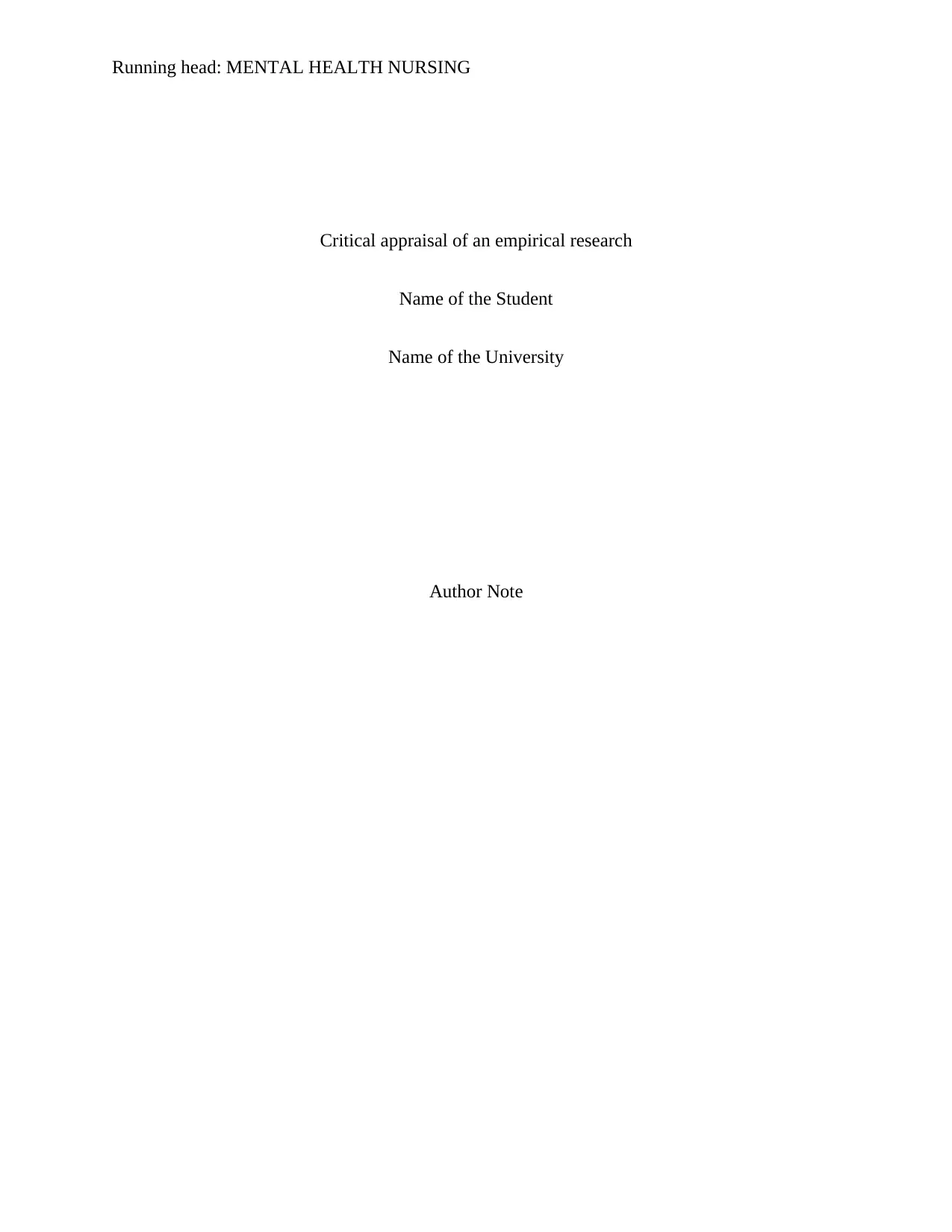
Critical appraisal of an empirical research
Name of the Student
Name of the University
Author Note
Paraphrase This Document

Executive summary
High turnover and shortage in nursing staff is a major concern in all countries due to the negative
impacts they create on the effectiveness and efficiency of all healthcare delivery systems. The
recruitment of adequate nursing staff and their retention are persistent problems that are
associated with job satisfaction and better care quality. The present report aims to critically
appraise a study that was conducted to test several hypotheses on data obtained from a registry of
nurses in Canada. The report will illustrate the negative effects on professional care, patient
safety and viability of hospital systems. It will propose future implications that can be put to
practice to reduce and prevent burnouts.

Table of Contents
A. Introduction...........................................................................................................................4
1) Background.......................................................................................................................4
2) Objectives..........................................................................................................................4
B. Methods................................................................................................................................5
1) Design...............................................................................................................................5
2) Participants........................................................................................................................6
3) Interventions......................................................................................................................6
4) Outcomes..........................................................................................................................6
5) Sample size.......................................................................................................................7
6) Statistical methods............................................................................................................7
7) Validity and Reliability.....................................................................................................8
C. Results...................................................................................................................................8
1) Participant flow.................................................................................................................8
2) Baseline data.....................................................................................................................9
3) Outcomes and estimation..................................................................................................9
D. Discussion.............................................................................................................................9
1) Limitations........................................................................................................................9
2) Future implications.........................................................................................................10
⊘ This is a preview!⊘
Do you want full access?
Subscribe today to unlock all pages.

Trusted by 1+ million students worldwide
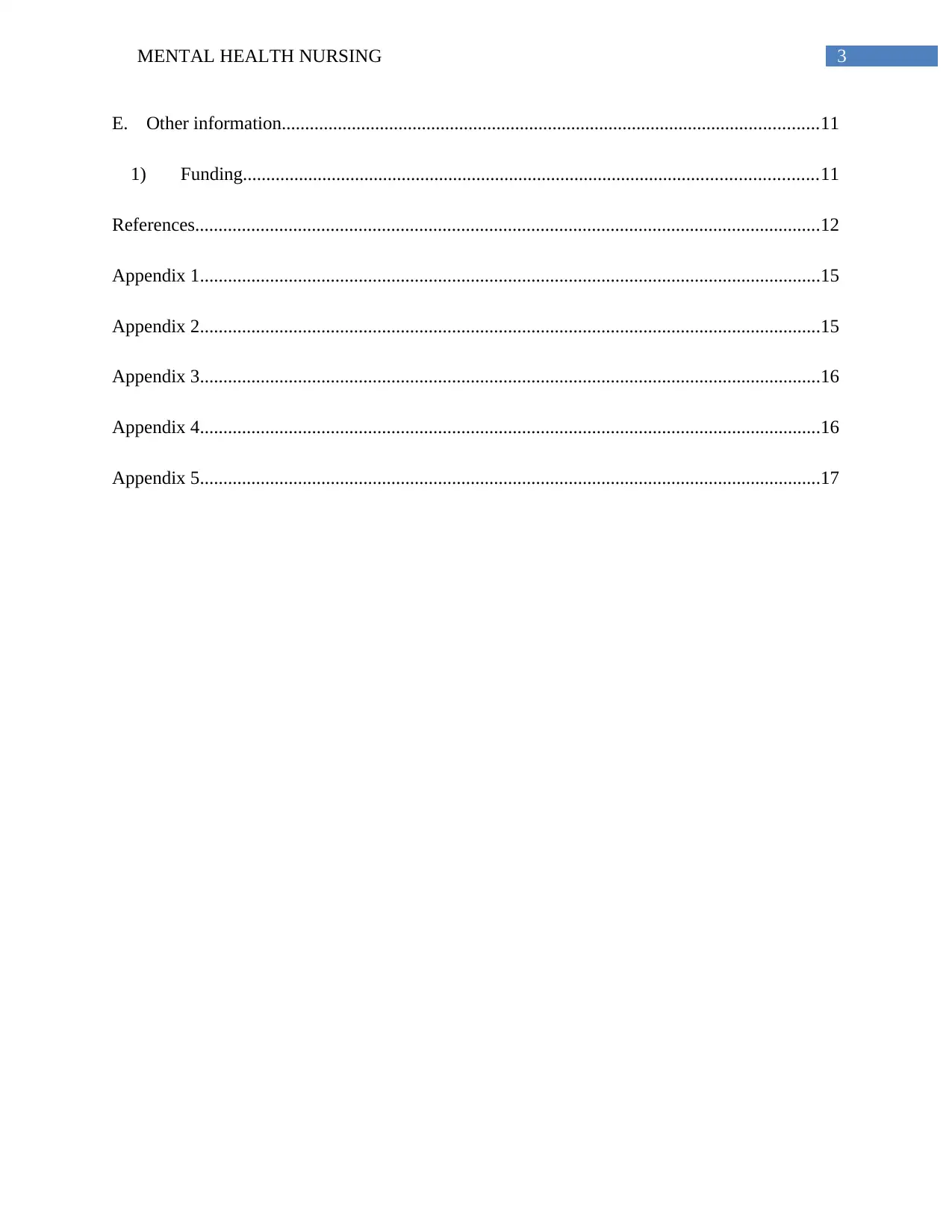
E. Other information...................................................................................................................11
1) Funding...........................................................................................................................11
References......................................................................................................................................12
Appendix 1.....................................................................................................................................15
Appendix 2.....................................................................................................................................15
Appendix 3.....................................................................................................................................16
Appendix 4.....................................................................................................................................16
Appendix 5.....................................................................................................................................17
Paraphrase This Document

A. Introduction
1) Background
Registered nurses are expected to demonstrate competence in their profession throughout the
career. It is their sole responsibility to remain accountable for the care they provide while
maintaining nursing standards and regulations for practice. The term burnout was first used by
Freudenberger in 1974 to describe the exhaustion experienced by mental healthcare professionals
at their workplace. Maslach gave a comprehensive definition for the term. Burnout was defined
as the physical and mental exhaustion that a professional faces while maintaining contact with
other people at work. Long stressful working hours give rise to this condition. Emotional
exhaustion, personal achievements and depersonalization are three major components of this
burnout. The negative effects of burnout affect the organization and create hindrance in the path
of providing holistic care to the patients and in ensuring their safety (Pulido‐Martos, Augusto‐
Landa & Lopez‐Zafra, 2012). Several studies have provided evidence for poor organizational
outcome, career dissatisfaction and reduction in patient satisfaction regarding physical and
mental health due to frequent burnouts among nurses (Cañadas-De la Fuente et al., 2015). This
report will critically appraise an empirical research that was carried out to determine the factors
influencing job satisfaction, burnout and healthcare quality delivered to patients by new graduate
nurses.
2) Objectives
Given the negative effects of nurse burnout on patient care quality, health infections and
avoidable adverse events, several studies have been undertaken to explore the factors that
influence the development of such mental and physical exhaustion among nurses. Data obtained
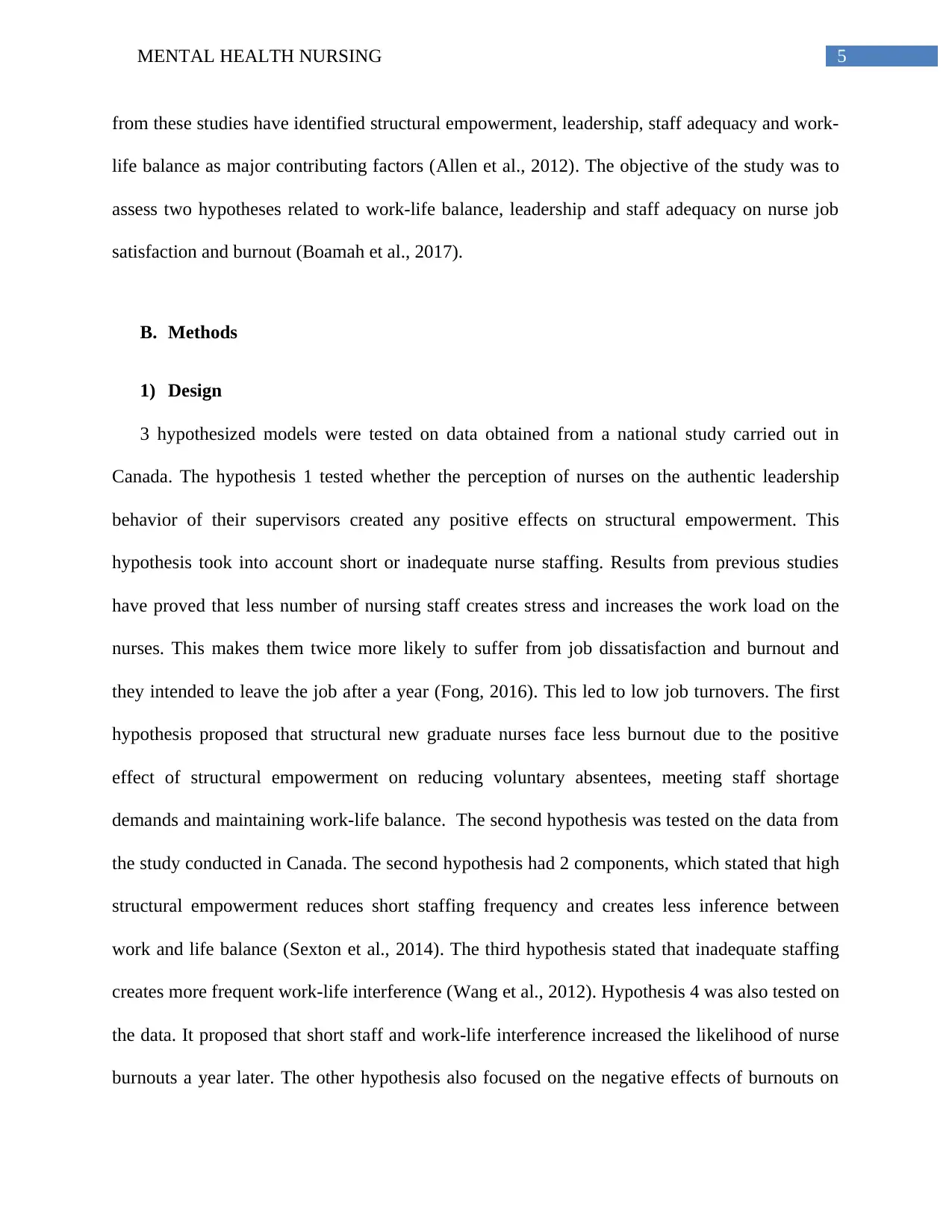
from these studies have identified structural empowerment, leadership, staff adequacy and work-
life balance as major contributing factors (Allen et al., 2012). The objective of the study was to
assess two hypotheses related to work-life balance, leadership and staff adequacy on nurse job
satisfaction and burnout (Boamah et al., 2017).
B. Methods
1) Design
3 hypothesized models were tested on data obtained from a national study carried out in
Canada. The hypothesis 1 tested whether the perception of nurses on the authentic leadership
behavior of their supervisors created any positive effects on structural empowerment. This
hypothesis took into account short or inadequate nurse staffing. Results from previous studies
have proved that less number of nursing staff creates stress and increases the work load on the
nurses. This makes them twice more likely to suffer from job dissatisfaction and burnout and
they intended to leave the job after a year (Fong, 2016). This led to low job turnovers. The first
hypothesis proposed that structural new graduate nurses face less burnout due to the positive
effect of structural empowerment on reducing voluntary absentees, meeting staff shortage
demands and maintaining work-life balance. The second hypothesis was tested on the data from
the study conducted in Canada. The second hypothesis had 2 components, which stated that high
structural empowerment reduces short staffing frequency and creates less inference between
work and life balance (Sexton et al., 2014). The third hypothesis stated that inadequate staffing
creates more frequent work-life interference (Wang et al., 2012). Hypothesis 4 was also tested on
the data. It proposed that short staff and work-life interference increased the likelihood of nurse
burnouts a year later. The other hypothesis also focused on the negative effects of burnouts on
⊘ This is a preview!⊘
Do you want full access?
Subscribe today to unlock all pages.

Trusted by 1+ million students worldwide
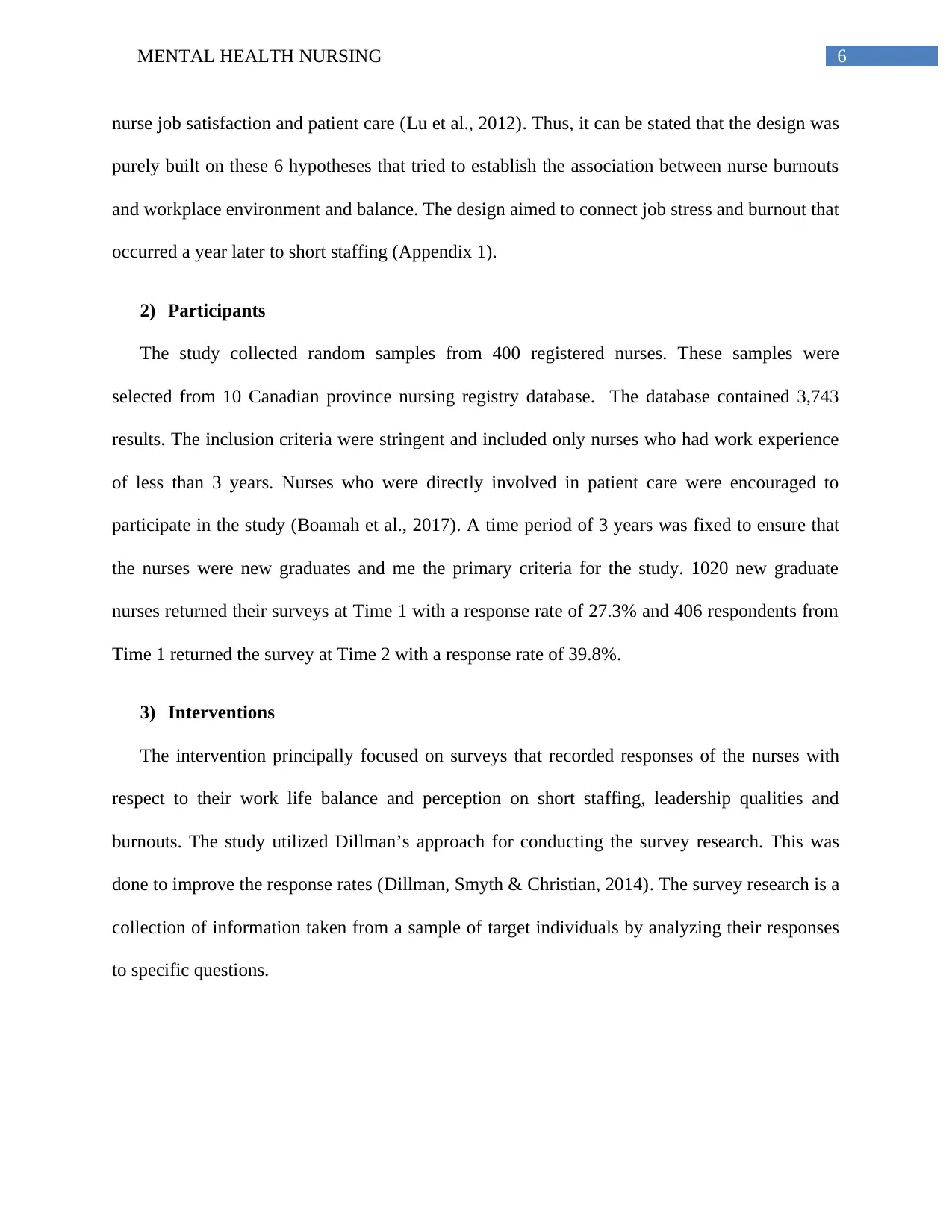
nurse job satisfaction and patient care (Lu et al., 2012). Thus, it can be stated that the design was
purely built on these 6 hypotheses that tried to establish the association between nurse burnouts
and workplace environment and balance. The design aimed to connect job stress and burnout that
occurred a year later to short staffing (Appendix 1).
2) Participants
The study collected random samples from 400 registered nurses. These samples were
selected from 10 Canadian province nursing registry database. The database contained 3,743
results. The inclusion criteria were stringent and included only nurses who had work experience
of less than 3 years. Nurses who were directly involved in patient care were encouraged to
participate in the study (Boamah et al., 2017). A time period of 3 years was fixed to ensure that
the nurses were new graduates and me the primary criteria for the study. 1020 new graduate
nurses returned their surveys at Time 1 with a response rate of 27.3% and 406 respondents from
Time 1 returned the survey at Time 2 with a response rate of 39.8%.
3) Interventions
The intervention principally focused on surveys that recorded responses of the nurses with
respect to their work life balance and perception on short staffing, leadership qualities and
burnouts. The study utilized Dillman’s approach for conducting the survey research. This was
done to improve the response rates (Dillman, Smyth & Christian, 2014). The survey research is a
collection of information taken from a sample of target individuals by analyzing their responses
to specific questions.
Paraphrase This Document
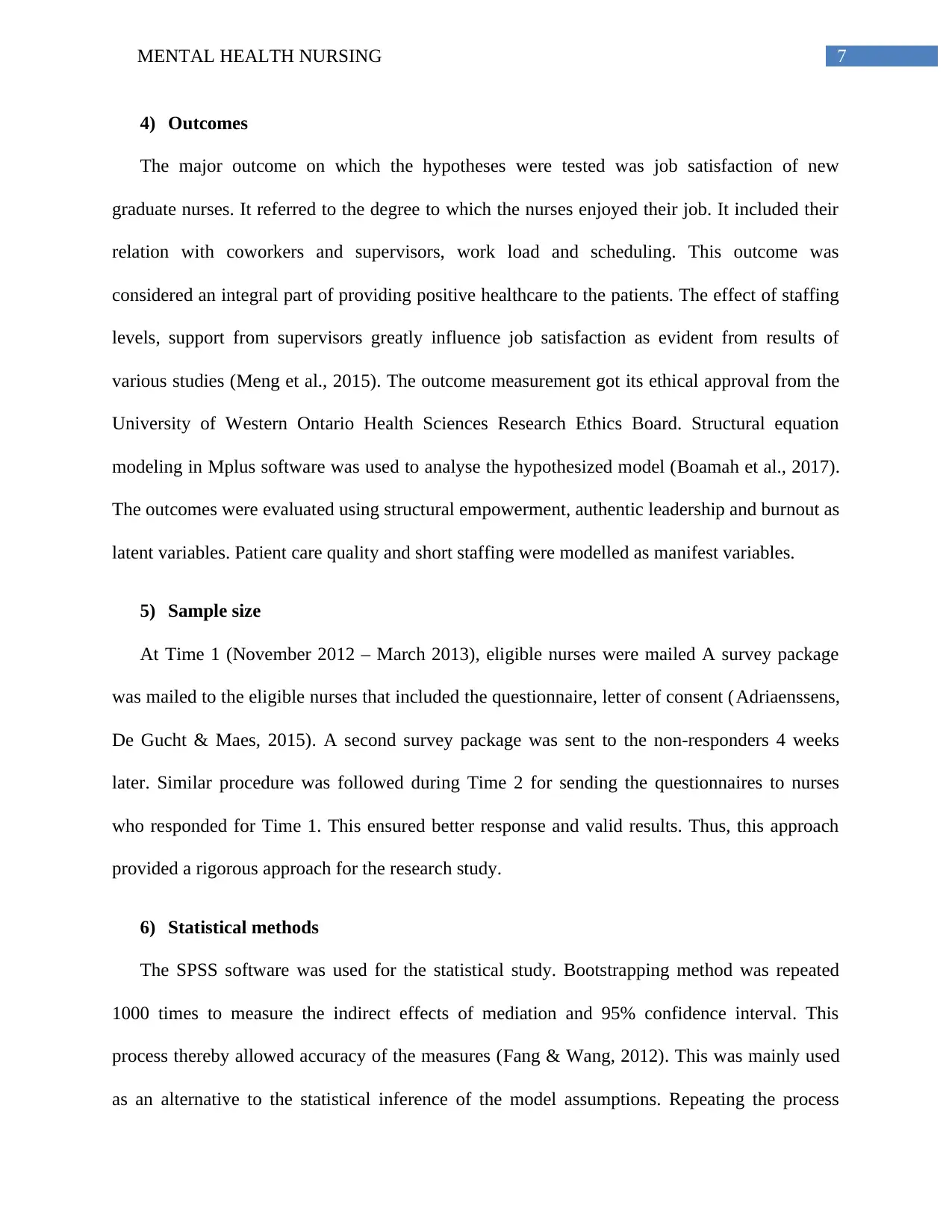
4) Outcomes
The major outcome on which the hypotheses were tested was job satisfaction of new
graduate nurses. It referred to the degree to which the nurses enjoyed their job. It included their
relation with coworkers and supervisors, work load and scheduling. This outcome was
considered an integral part of providing positive healthcare to the patients. The effect of staffing
levels, support from supervisors greatly influence job satisfaction as evident from results of
various studies (Meng et al., 2015). The outcome measurement got its ethical approval from the
University of Western Ontario Health Sciences Research Ethics Board. Structural equation
modeling in Mplus software was used to analyse the hypothesized model (Boamah et al., 2017).
The outcomes were evaluated using structural empowerment, authentic leadership and burnout as
latent variables. Patient care quality and short staffing were modelled as manifest variables.
5) Sample size
At Time 1 (November 2012 – March 2013), eligible nurses were mailed A survey package
was mailed to the eligible nurses that included the questionnaire, letter of consent (Adriaenssens,
De Gucht & Maes, 2015). A second survey package was sent to the non-responders 4 weeks
later. Similar procedure was followed during Time 2 for sending the questionnaires to nurses
who responded for Time 1. This ensured better response and valid results. Thus, this approach
provided a rigorous approach for the research study.
6) Statistical methods
The SPSS software was used for the statistical study. Bootstrapping method was repeated
1000 times to measure the indirect effects of mediation and 95% confidence interval. This
process thereby allowed accuracy of the measures (Fang & Wang, 2012). This was mainly used
as an alternative to the statistical inference of the model assumptions. Repeating the process
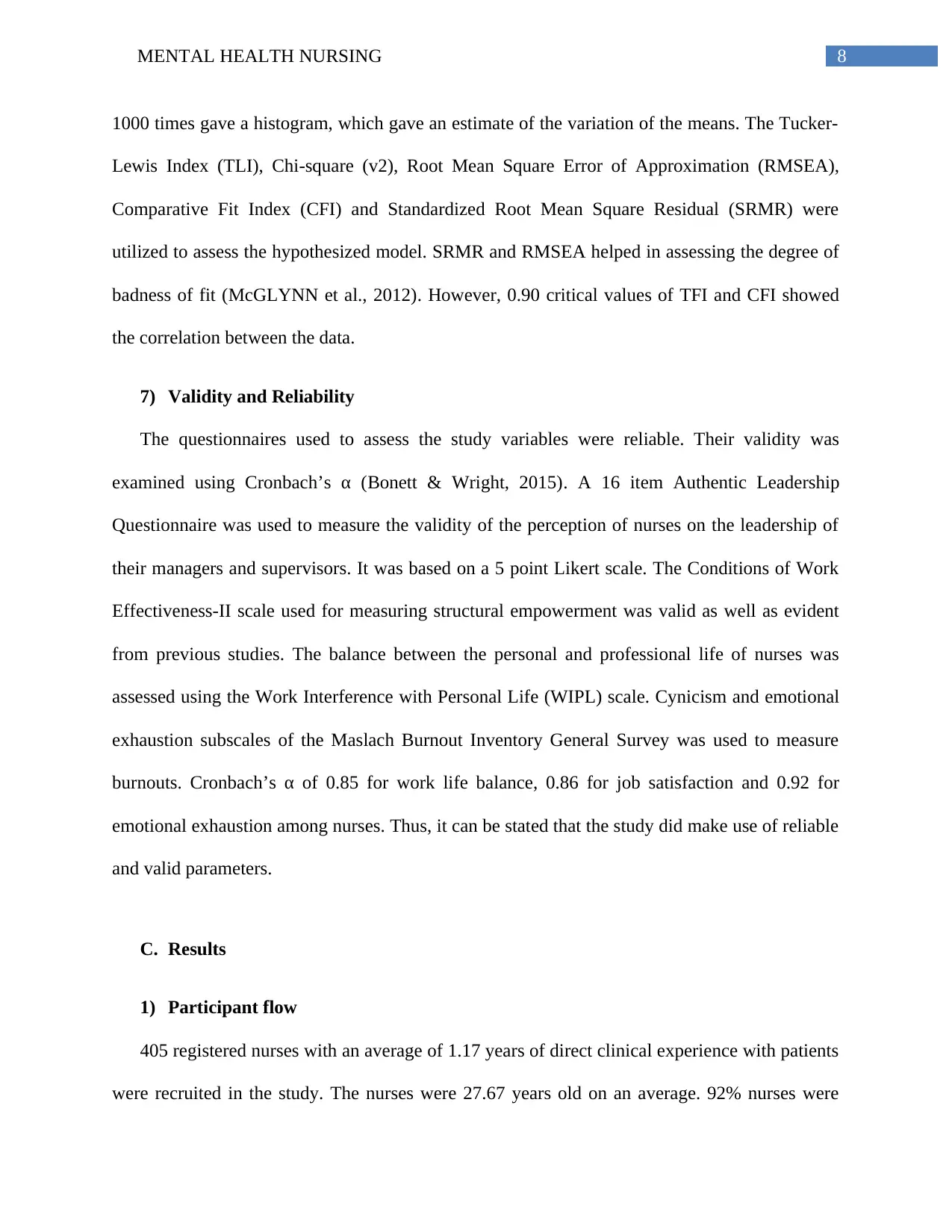
1000 times gave a histogram, which gave an estimate of the variation of the means. The Tucker-
Lewis Index (TLI), Chi-square (v2), Root Mean Square Error of Approximation (RMSEA),
Comparative Fit Index (CFI) and Standardized Root Mean Square Residual (SRMR) were
utilized to assess the hypothesized model. SRMR and RMSEA helped in assessing the degree of
badness of fit (McGLYNN et al., 2012). However, 0.90 critical values of TFI and CFI showed
the correlation between the data.
7) Validity and Reliability
The questionnaires used to assess the study variables were reliable. Their validity was
examined using Cronbach’s α (Bonett & Wright, 2015). A 16 item Authentic Leadership
Questionnaire was used to measure the validity of the perception of nurses on the leadership of
their managers and supervisors. It was based on a 5 point Likert scale. The Conditions of Work
Effectiveness-II scale used for measuring structural empowerment was valid as well as evident
from previous studies. The balance between the personal and professional life of nurses was
assessed using the Work Interference with Personal Life (WIPL) scale. Cynicism and emotional
exhaustion subscales of the Maslach Burnout Inventory General Survey was used to measure
burnouts. Cronbach’s α of 0.85 for work life balance, 0.86 for job satisfaction and 0.92 for
emotional exhaustion among nurses. Thus, it can be stated that the study did make use of reliable
and valid parameters.
C. Results
1) Participant flow
405 registered nurses with an average of 1.17 years of direct clinical experience with patients
were recruited in the study. The nurses were 27.67 years old on an average. 92% nurses were
⊘ This is a preview!⊘
Do you want full access?
Subscribe today to unlock all pages.

Trusted by 1+ million students worldwide
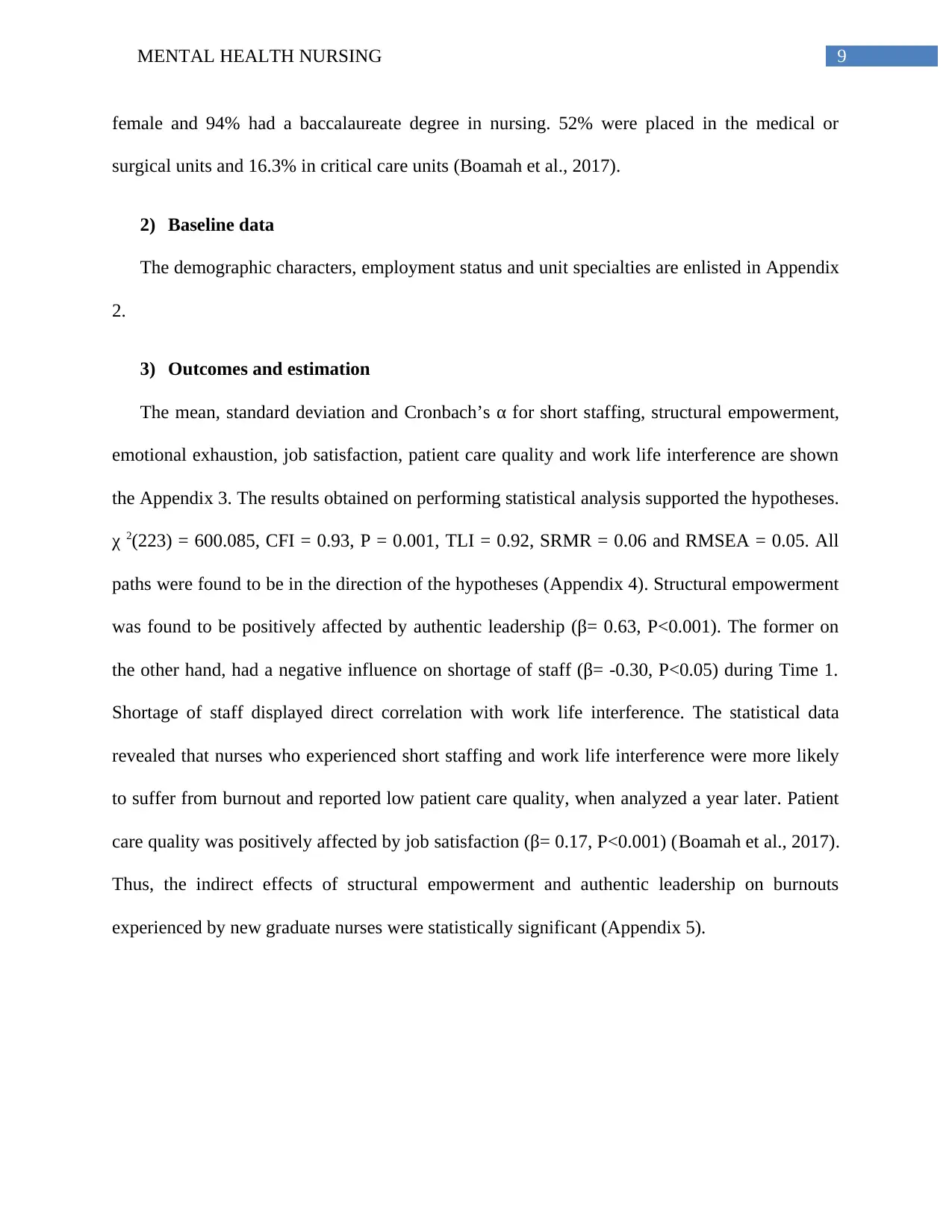
female and 94% had a baccalaureate degree in nursing. 52% were placed in the medical or
surgical units and 16.3% in critical care units (Boamah et al., 2017).
2) Baseline data
The demographic characters, employment status and unit specialties are enlisted in Appendix
2.
3) Outcomes and estimation
The mean, standard deviation and Cronbach’s α for short staffing, structural empowerment,
emotional exhaustion, job satisfaction, patient care quality and work life interference are shown
the Appendix 3. The results obtained on performing statistical analysis supported the hypotheses.
χ 2(223) = 600.085, CFI = 0.93, P = 0.001, TLI = 0.92, SRMR = 0.06 and RMSEA = 0.05. All
paths were found to be in the direction of the hypotheses (Appendix 4). Structural empowerment
was found to be positively affected by authentic leadership (β= 0.63, P<0.001). The former on
the other hand, had a negative influence on shortage of staff (β= -0.30, P<0.05) during Time 1.
Shortage of staff displayed direct correlation with work life interference. The statistical data
revealed that nurses who experienced short staffing and work life interference were more likely
to suffer from burnout and reported low patient care quality, when analyzed a year later. Patient
care quality was positively affected by job satisfaction (β= 0.17, P<0.001) (Boamah et al., 2017).
Thus, the indirect effects of structural empowerment and authentic leadership on burnouts
experienced by new graduate nurses were statistically significant (Appendix 5).
Paraphrase This Document
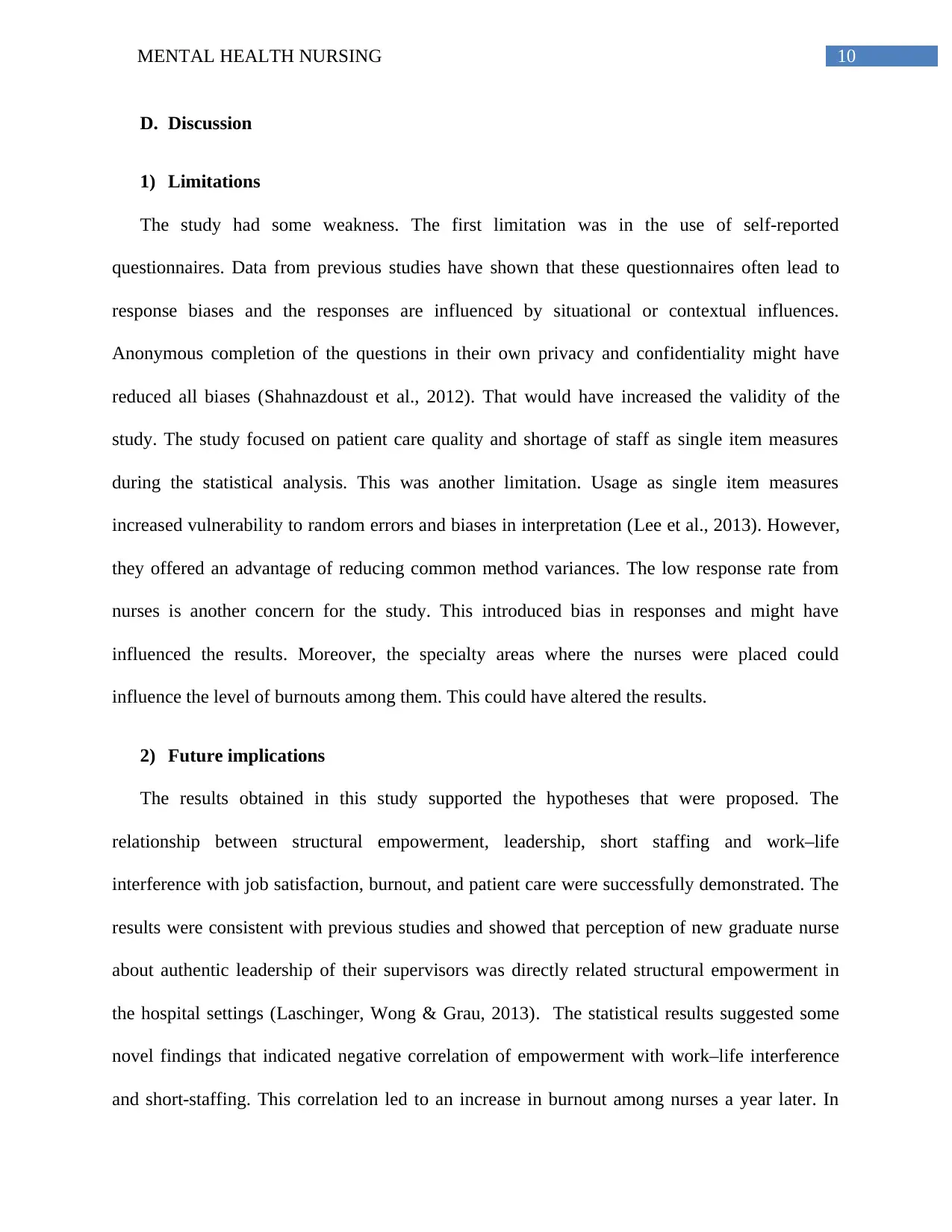
D. Discussion
1) Limitations
The study had some weakness. The first limitation was in the use of self-reported
questionnaires. Data from previous studies have shown that these questionnaires often lead to
response biases and the responses are influenced by situational or contextual influences.
Anonymous completion of the questions in their own privacy and confidentiality might have
reduced all biases (Shahnazdoust et al., 2012). That would have increased the validity of the
study. The study focused on patient care quality and shortage of staff as single item measures
during the statistical analysis. This was another limitation. Usage as single item measures
increased vulnerability to random errors and biases in interpretation (Lee et al., 2013). However,
they offered an advantage of reducing common method variances. The low response rate from
nurses is another concern for the study. This introduced bias in responses and might have
influenced the results. Moreover, the specialty areas where the nurses were placed could
influence the level of burnouts among them. This could have altered the results.
2) Future implications
The results obtained in this study supported the hypotheses that were proposed. The
relationship between structural empowerment, leadership, short staffing and work–life
interference with job satisfaction, burnout, and patient care were successfully demonstrated. The
results were consistent with previous studies and showed that perception of new graduate nurse
about authentic leadership of their supervisors was directly related structural empowerment in
the hospital settings (Laschinger, Wong & Grau, 2013). The statistical results suggested some
novel findings that indicated negative correlation of empowerment with work–life interference
and short-staffing. This correlation led to an increase in burnout among nurses a year later. In
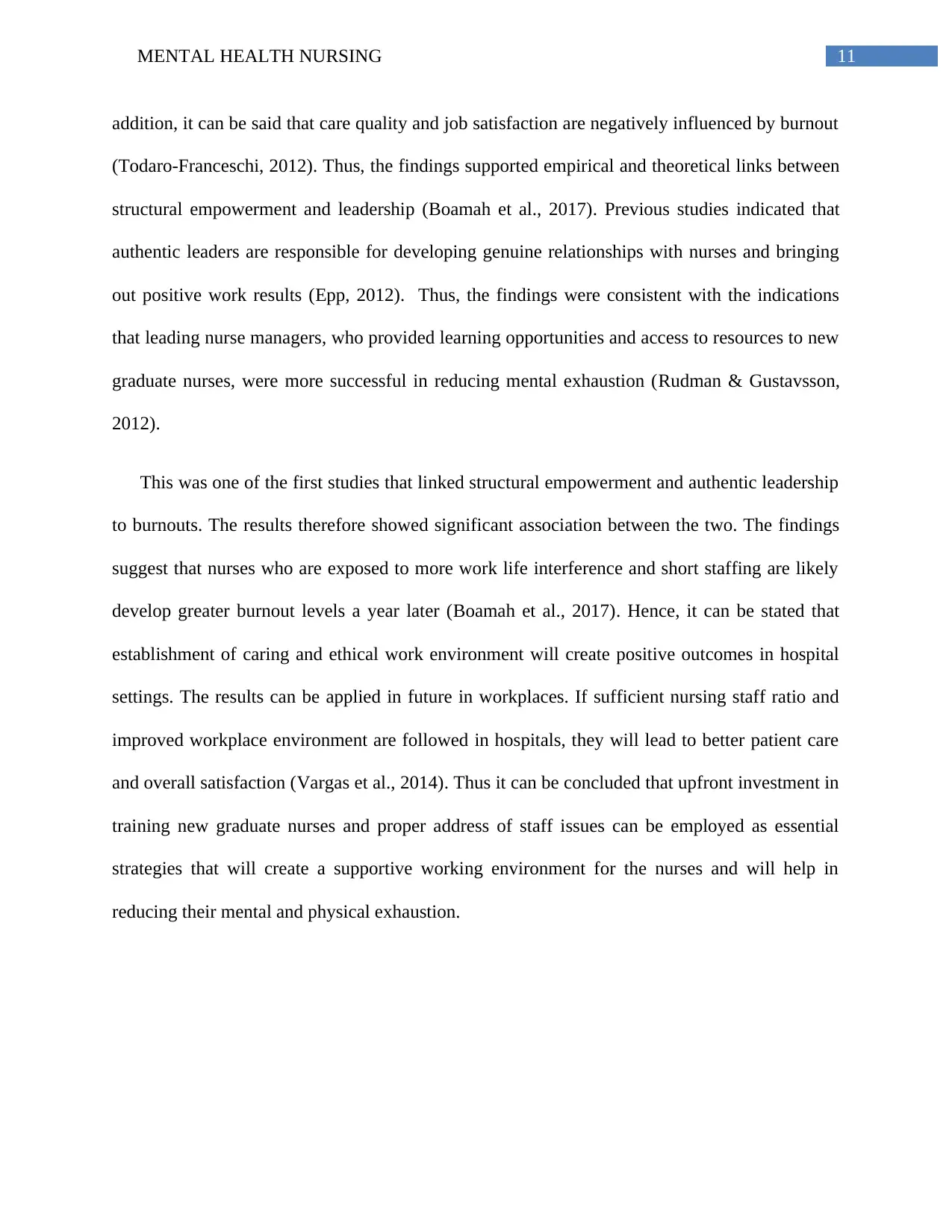
addition, it can be said that care quality and job satisfaction are negatively influenced by burnout
(Todaro-Franceschi, 2012). Thus, the findings supported empirical and theoretical links between
structural empowerment and leadership (Boamah et al., 2017). Previous studies indicated that
authentic leaders are responsible for developing genuine relationships with nurses and bringing
out positive work results (Epp, 2012). Thus, the findings were consistent with the indications
that leading nurse managers, who provided learning opportunities and access to resources to new
graduate nurses, were more successful in reducing mental exhaustion (Rudman & Gustavsson,
2012).
This was one of the first studies that linked structural empowerment and authentic leadership
to burnouts. The results therefore showed significant association between the two. The findings
suggest that nurses who are exposed to more work life interference and short staffing are likely
develop greater burnout levels a year later (Boamah et al., 2017). Hence, it can be stated that
establishment of caring and ethical work environment will create positive outcomes in hospital
settings. The results can be applied in future in workplaces. If sufficient nursing staff ratio and
improved workplace environment are followed in hospitals, they will lead to better patient care
and overall satisfaction (Vargas et al., 2014). Thus it can be concluded that upfront investment in
training new graduate nurses and proper address of staff issues can be employed as essential
strategies that will create a supportive working environment for the nurses and will help in
reducing their mental and physical exhaustion.
⊘ This is a preview!⊘
Do you want full access?
Subscribe today to unlock all pages.

Trusted by 1+ million students worldwide

E. Other information
1) Funding
The Canadian Institutes for Health Research Partnerships for Health Systems Improvement
(#122182) was the main funding institute for the study. It was supported by other hospitals and
registered nurses institutes as well.
Paraphrase This Document
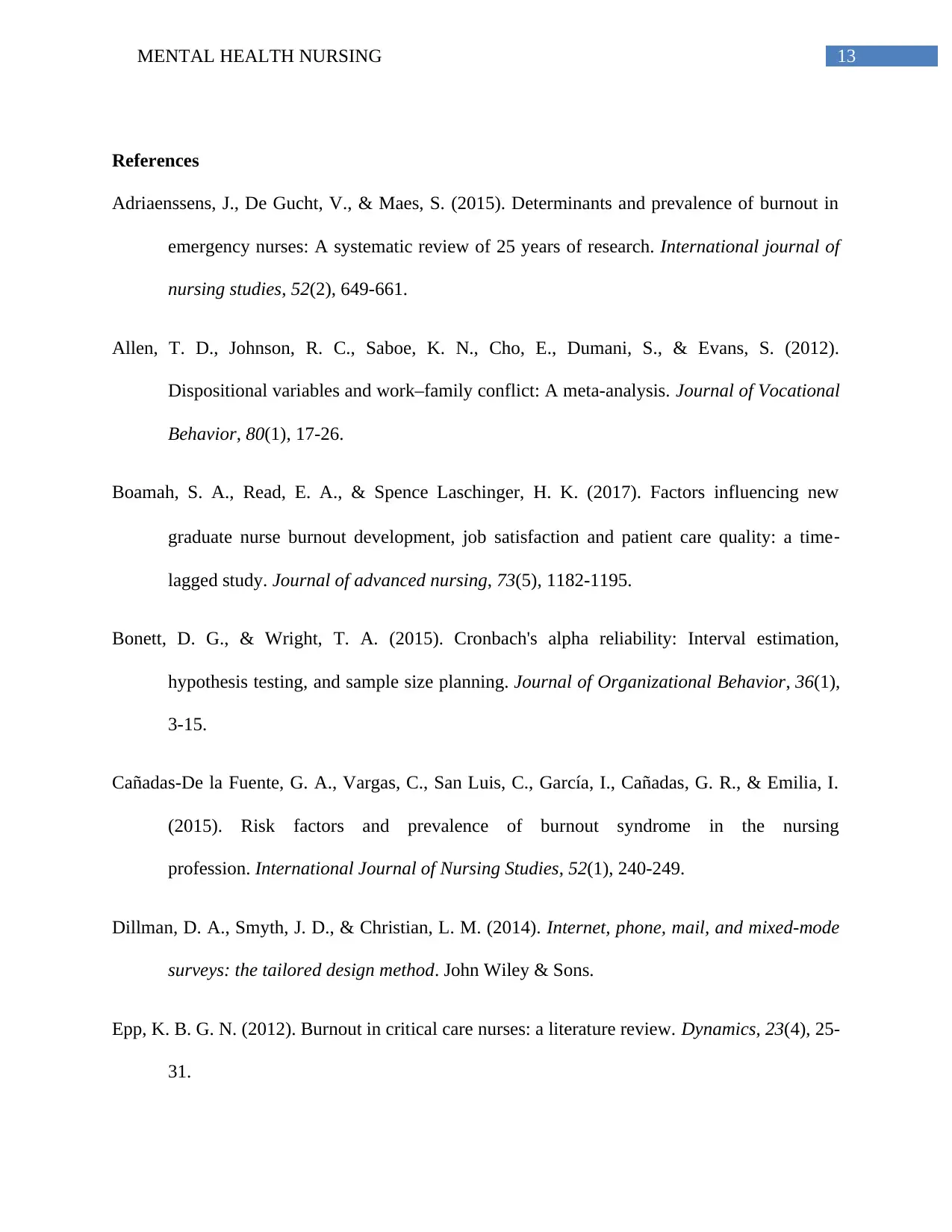
References
Adriaenssens, J., De Gucht, V., & Maes, S. (2015). Determinants and prevalence of burnout in
emergency nurses: A systematic review of 25 years of research. International journal of
nursing studies, 52(2), 649-661.
Allen, T. D., Johnson, R. C., Saboe, K. N., Cho, E., Dumani, S., & Evans, S. (2012).
Dispositional variables and work–family conflict: A meta-analysis. Journal of Vocational
Behavior, 80(1), 17-26.
Boamah, S. A., Read, E. A., & Spence Laschinger, H. K. (2017). Factors influencing new
graduate nurse burnout development, job satisfaction and patient care quality: a time‐
lagged study. Journal of advanced nursing, 73(5), 1182-1195.
Bonett, D. G., & Wright, T. A. (2015). Cronbach's alpha reliability: Interval estimation,
hypothesis testing, and sample size planning. Journal of Organizational Behavior, 36(1),
3-15.
Cañadas-De la Fuente, G. A., Vargas, C., San Luis, C., García, I., Cañadas, G. R., & Emilia, I.
(2015). Risk factors and prevalence of burnout syndrome in the nursing
profession. International Journal of Nursing Studies, 52(1), 240-249.
Dillman, D. A., Smyth, J. D., & Christian, L. M. (2014). Internet, phone, mail, and mixed-mode
surveys: the tailored design method. John Wiley & Sons.
Epp, K. B. G. N. (2012). Burnout in critical care nurses: a literature review. Dynamics, 23(4), 25-
31.
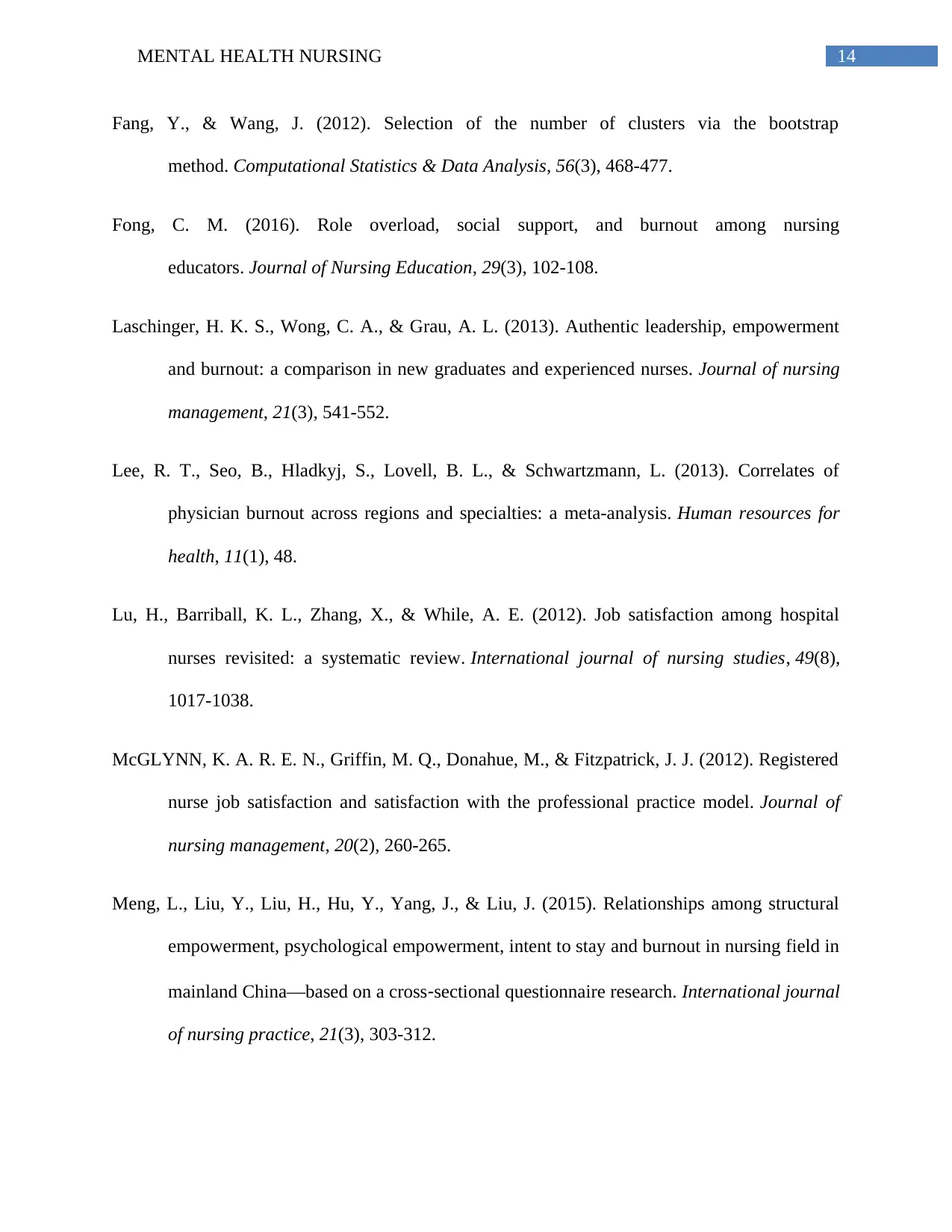
Fang, Y., & Wang, J. (2012). Selection of the number of clusters via the bootstrap
method. Computational Statistics & Data Analysis, 56(3), 468-477.
Fong, C. M. (2016). Role overload, social support, and burnout among nursing
educators. Journal of Nursing Education, 29(3), 102-108.
Laschinger, H. K. S., Wong, C. A., & Grau, A. L. (2013). Authentic leadership, empowerment
and burnout: a comparison in new graduates and experienced nurses. Journal of nursing
management, 21(3), 541-552.
Lee, R. T., Seo, B., Hladkyj, S., Lovell, B. L., & Schwartzmann, L. (2013). Correlates of
physician burnout across regions and specialties: a meta-analysis. Human resources for
health, 11(1), 48.
Lu, H., Barriball, K. L., Zhang, X., & While, A. E. (2012). Job satisfaction among hospital
nurses revisited: a systematic review. International journal of nursing studies, 49(8),
1017-1038.
McGLYNN, K. A. R. E. N., Griffin, M. Q., Donahue, M., & Fitzpatrick, J. J. (2012). Registered
nurse job satisfaction and satisfaction with the professional practice model. Journal of
nursing management, 20(2), 260-265.
Meng, L., Liu, Y., Liu, H., Hu, Y., Yang, J., & Liu, J. (2015). Relationships among structural
empowerment, psychological empowerment, intent to stay and burnout in nursing field in
mainland China—based on a cross‐sectional questionnaire research. International journal
of nursing practice, 21(3), 303-312.
⊘ This is a preview!⊘
Do you want full access?
Subscribe today to unlock all pages.

Trusted by 1+ million students worldwide
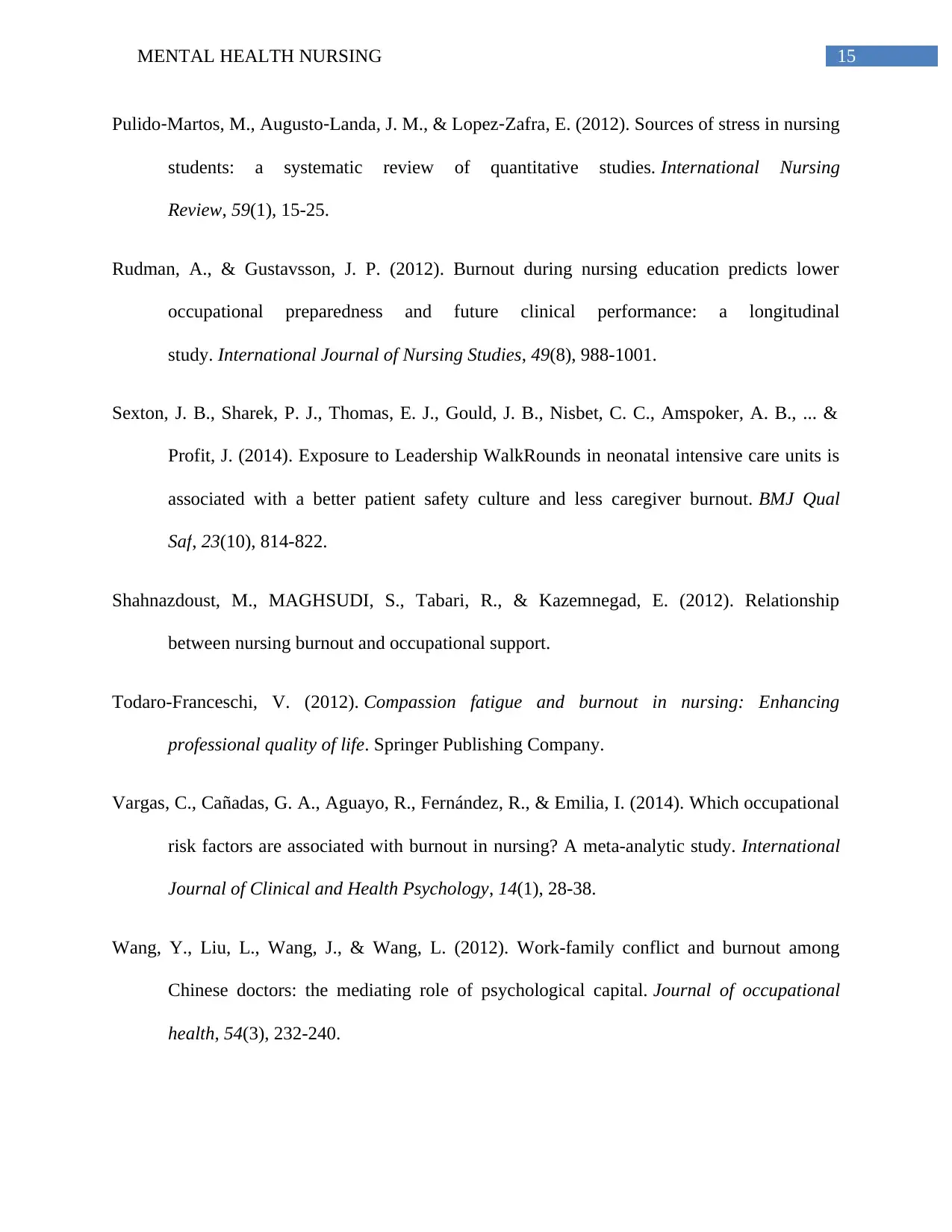
Pulido‐Martos, M., Augusto‐Landa, J. M., & Lopez‐Zafra, E. (2012). Sources of stress in nursing
students: a systematic review of quantitative studies. International Nursing
Review, 59(1), 15-25.
Rudman, A., & Gustavsson, J. P. (2012). Burnout during nursing education predicts lower
occupational preparedness and future clinical performance: a longitudinal
study. International Journal of Nursing Studies, 49(8), 988-1001.
Sexton, J. B., Sharek, P. J., Thomas, E. J., Gould, J. B., Nisbet, C. C., Amspoker, A. B., ... &
Profit, J. (2014). Exposure to Leadership WalkRounds in neonatal intensive care units is
associated with a better patient safety culture and less caregiver burnout. BMJ Qual
Saf, 23(10), 814-822.
Shahnazdoust, M., MAGHSUDI, S., Tabari, R., & Kazemnegad, E. (2012). Relationship
between nursing burnout and occupational support.
Todaro-Franceschi, V. (2012). Compassion fatigue and burnout in nursing: Enhancing
professional quality of life. Springer Publishing Company.
Vargas, C., Cañadas, G. A., Aguayo, R., Fernández, R., & Emilia, I. (2014). Which occupational
risk factors are associated with burnout in nursing? A meta-analytic study. International
Journal of Clinical and Health Psychology, 14(1), 28-38.
Wang, Y., Liu, L., Wang, J., & Wang, L. (2012). Work-family conflict and burnout among
Chinese doctors: the mediating role of psychological capital. Journal of occupational
health, 54(3), 232-240.
Paraphrase This Document
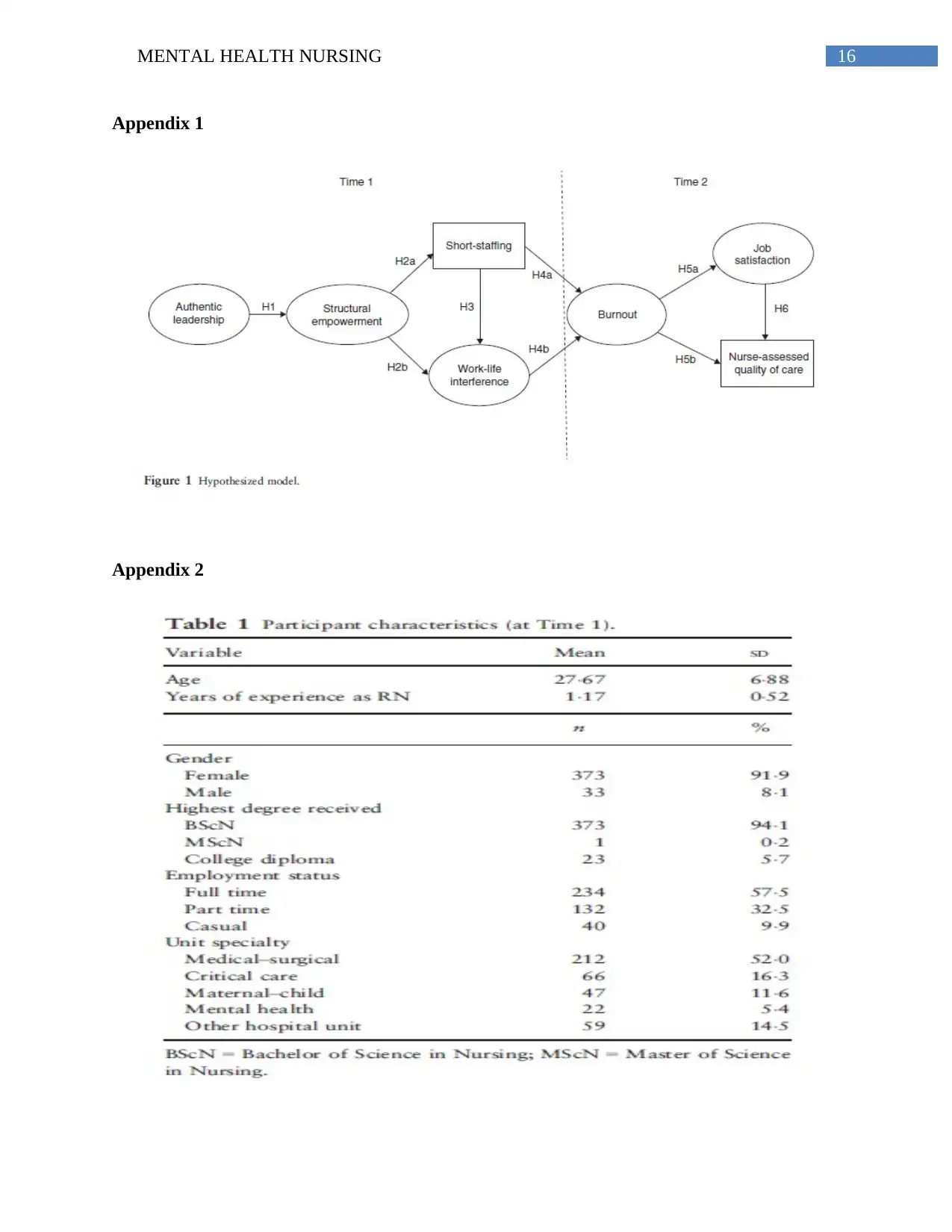
Appendix 1
Appendix 2
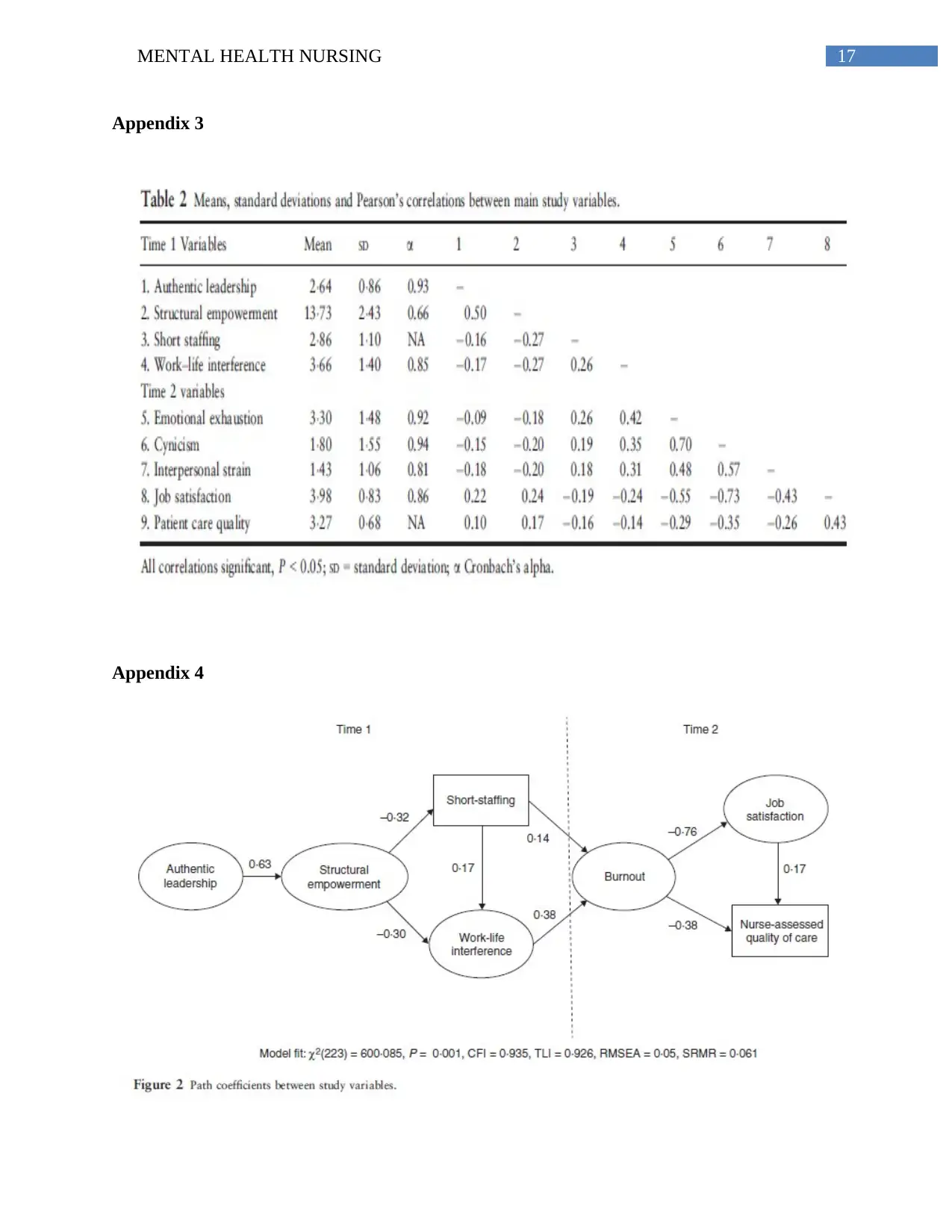
Appendix 3
Appendix 4
⊘ This is a preview!⊘
Do you want full access?
Subscribe today to unlock all pages.

Trusted by 1+ million students worldwide
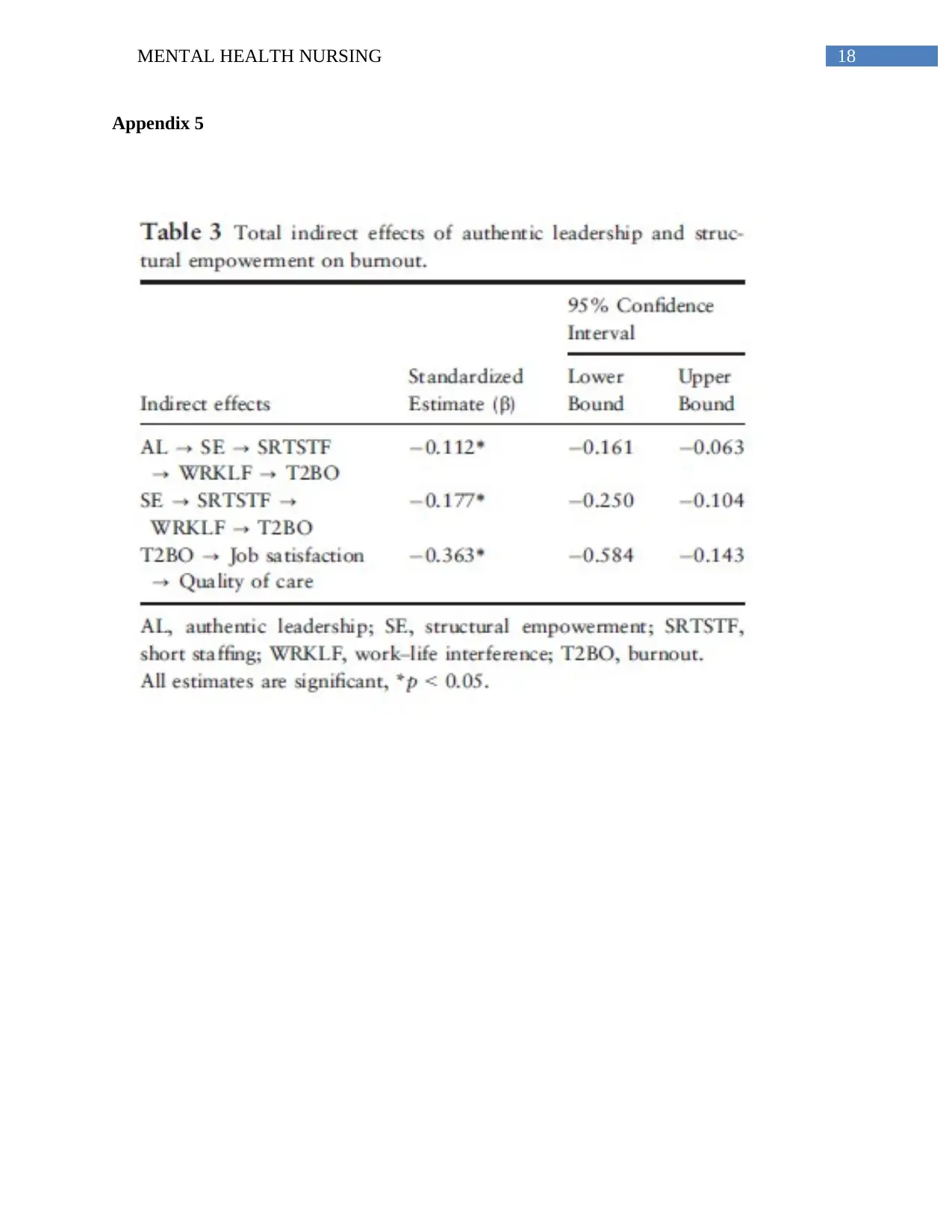
Appendix 5
Related Documents
Your All-in-One AI-Powered Toolkit for Academic Success.
+13062052269
info@desklib.com
Available 24*7 on WhatsApp / Email
![[object Object]](/_next/static/media/star-bottom.7253800d.svg)
© 2024 | Zucol Services PVT LTD | All rights reserved.





